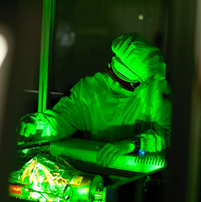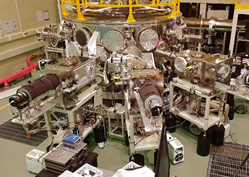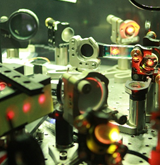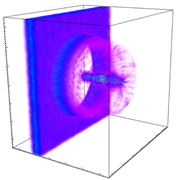Center for Relativistic Laser ScienceExplore the interaction between ultra-intense light and matter
mainmenu
▪ Welcome to CoReLS
The Center for Relativistic Laser Science (CoReLS) of Institute for Basic Science was established in December 2012 to explore novel physical phenomena in the relativistic laser intensity regime. The electron motion enters the relativistic regime at the laser intensity of 1018 W/cm2 , while protons behave relativistically at 1024 W/cm2 . To tackle the underlying physics of relativistic laser-matter interactions, the center utilizes a petawatt (PW) laser facility located in the campus of Gwangju Institute of Science and Technology (GIST). The peak intensity of 1023 W/cm2 has been achieved in 2020, which is currently the highest laser intensity achieved in the world. It is a challenging task to reveal the physics of relativistic and ultra-relativistic laser-matter interactions. We examine the fundamental physical processes in atoms, molecules, plasmas, explore subatomic entities occurring in an ultrafast timescale (atto- to zepto-second), and develop high-energy, ultra-short particle (electron, proton, and ion) beams and radiation (X-ray and γ-ray) sources. Sophisticated methods to control the spatio-temporal structure of ultra-intense laser pulses have been developed to precisely manipulate relativistic laser-matter interactions. Such developments will allow us to achieve our goals by steering the interaction processes (e.g., relativistic harmonic generation at extreme orders, mono-energetic electron acceleration over GeV, energetic proton generation with narrow bandwidths; strong X-ray and γ-ray generation).
▪ Main research subjects of CoReLS
· Developing cutting-edge technologies in the field of ultra-high intensity lasers
· Examining physics of laser-matter interactions under extreme conditions
· Exploring strong field quantum electrodynamics, especially nonlinear Compton scattering
· Investigating laboratory astrophysics with PW lasers
· Exploring attosecond and zeptosecond phenomena in atoms, molecules, solids and nano-structures
▪ Main research groups
· In order to achieve the aims of the center, six research groups are working together:

▪ Scientific advisory committee
· See Leang Chin (Secretary) Professor Emeritus, Laval University, Canada
· Yoshiaki Kato (Chair) Professor, The Graduate School for the Creation of New Photonics Industries, Japan
· Jongmin Lee Chair Professor, Handong Global University, Korea
· In Won Lee Chief Technology Officer, 3L-Systems, Korea
· Gérard Mourou Professor & Director of International Center for Zettawatt and Exawatt Science and Technology
(IZEST), École Polytechnique, France
· Won Namkung Executive Advisor & Prof. Emeritus, POSTECH, Korea
· Peter V. Nickles Former Department Head, Max Born Institute, Germany
▪ Laser group: development and operation of multi-PW lasers
|
The PW laser system at CoReLS will be continuously upgraded to obtain the highest laser intensity. Achieving a ultrahigh laser intensity is a challenging task that requires cutting-edge laser technologies, such as highly efficient broadband amplification, contrast enhancement, wavefront control, and tight focusing techniques. The ongoing development of laser technologies is essential for sustaining excellence in research activities. |
▪ Low density laser-plasma group: generation and application of high-energy electron beams
We investigate the interactions between super-intense laser pulses and under-dense plasma to produce multi-GeV electron beams through Laser Wakefield Acceleration (LWFA). The high-energy electron beams can be used to generate unique (highly bright, ultra-short, spectrally narrow) high-energy radiations (X-ray or γ-ray), which can be powerful tools for nanomaterial and biomaterial research in ultrafast timescales. The low density laer-plasma group has intensively worked on nonlinear Compton scattering between a multi-GeV electron beam and an ultrahigh intensity laser pulse to reveal strong field quantum electrodynamic processes. | |
▪ High density laser-plasma group: generation and application of energetic proton/ion beams
| We conduct research on the generation of protons/ions with the energy of several hundred MeV by applying super-intense laser pulses to ultrathin solid targets and exploring underlying physical mechanisms. The realization of radiation pressure acceleration for protons/ions is important because energetic proton/ion beams can be produced in an efficient way. Energetic proton/ion beams can be used as new imaging tools for matter under extreme physical conditions and for novel laser cancer-therapy machines. |
▪ Attosecond science group: research on ultrafast phenomena
Attosecond (10-18s) light pulses can be produced from gaseous and solid targets irradiated by ultra-intense laser pulses through high harmonic generation. The physical conditions for extending high harmonic orders to support attosecond and even zeptosecond (10-21s) pulses are being investigated. Ultrafast physical processes in atoms, molecules, and plasmas can be explored using attosecond pulses. In addition, the generation of zeptosecond pulses will make it possible to investigate nuclear dynamics. Such research should expand new horizons in ultrafast optical science and advance our understanding of ultrafast phenomena. |
|
▪ Laser-plasma theory group: fundamental physics of ultra-intense light-matter interactions
| Ultra-intense lasers lead us to an unexplored territory of physics, to which other terrestrial means cannot. Upon impinging on a material, an ultra-intense laser field immediately turns the material into a plasma exhibiting novel phenomena, such as collective relativistic plasma motions, strong radiation reaction effects, and nonlinear quantum electrodynamic processes. The dynamics in such a physical system is highly nonlinear, couples multiple frameworks of physics (classical electrodynamics and quantum electrodynamics), and is embodied through the processes at multiple spacetime scales. Understanding the new physics of such extreme conditions and utilizing it for other scientific or technological purposes has been a highly fascinating research opportunity for the last two decades. The group investigates the physics problems in ultra-intense laser-plasma interactions by performing particle-in-cell and hydrodynamic simulations. The group also closely collaborates with the experimental groups by proposing new schemes, numerically testing experimental setups, and interpreting experimental results. |
▪ High energy density physics group: warm dense matter and nuclear fusion studies
High energy density (HED) science is defined as the study of matter at extreme radiation, pressure, and temperature corresponding to energy densities in excess of about 1011 J/m3. HED conditions are widespread in the universe and in laboratories. Within the regime of HED states, warm dense matter (WDM) represents the state in which the thermal energy is comparable to the Fermi energy and ions are strongly coupled. With recent development of high power lasers and x‐ray light sources, quantitative physics experiments such as creation and diagnosis of a single-state WDM became feasible in laboratory. Taking such advantages, the HEDP group has been working on electronic structure of WDM, EOS, opacity, energy transport in HED matter, fusion cross section, pair-production, development of advanced x-ray diagnostics and has plans to investigate further for deeper understanding of fundamental properties of matter under high energy density conditions. |
|








